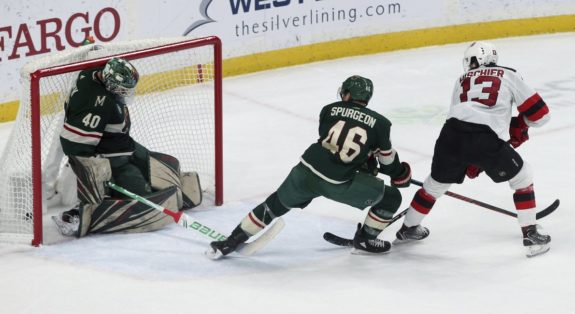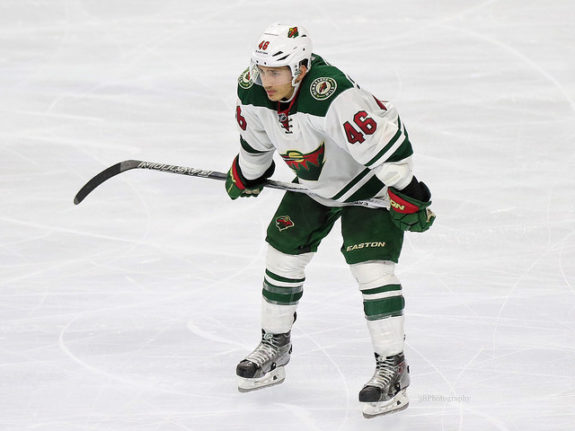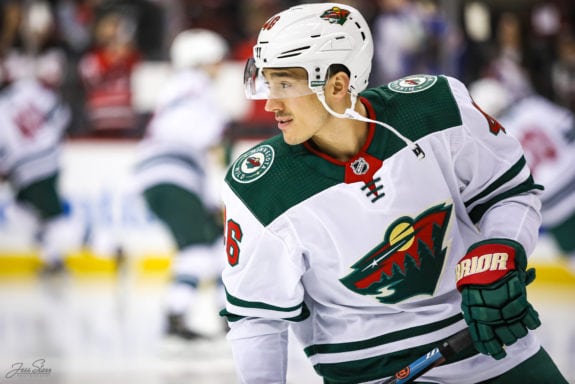At the beginning of the 2020-21 campaign, Jared Spurgeon was awarded the captaincy of the Wild. He’s had big skates to fill with the team moving on from longtime leader Mikko Koivu during the off-season. Overall, Minnesota has performed well and restructured everyone’s perceptions of the State of Hockey’s professional team. But, on a personal level, the 31-year-old defender is struggling to produce at the rate that’s helped establish himself as one of the best two-way skaters in the NHL.

Throughout his entire career, Spurgeon has been relied on to contribute offensively while also taking on tough defensive assignments. In his 11 years in the NHL, the small-statured defenseman has found creatively effective ways to help manufacture offense. He does this by pinching up in the offensive zone and facilitating play with the forwards down by the circles and around the crease. In addition to this, his on-ice mental alertness helps him understand when to gamble in his opponent’s end or step back into defensive coverage. This quality of play makes him extremely vital to the Wild’s long-term success and is a big reason the team’s underlying numbers have remained consistent over the past decade.
Team-wise, this level of consistency has remained intact. In fact, the Wild are one of the most productive teams in the entire NHL in terms of goals for percentage and expected goals-for percentage. This means that, for the most part, Minnesota is doing a relatively good job at dictating the game’s flow and converting shots into goals. Skaters like Joel Eriksson Ek, Jordan Greenway, and even Jonas Brodin are all on pace to set career highs. And while this is excellent news for those players and the overall well-being of the roster, the Wild would benefit from more production out of their captain.
Potentially Playing Hurt
Things aren’t coming that easy to Spurgeon here in the beginning stages of the 2020-21 season. He suffered an upper-body injury that coincided with Minnesota’s extended shutdown due to health protocols. With the team facilities in flux and the severity of the outbreak unknown, rehab and recovery were difficult for the defenseman. Nevertheless, due to the two-week hiatus, Minnesota’s captain only missed one total game. And even though it’s unclear what exact injury he suffered, it wouldn’t be a stretch to say that it might be what’s holding him back from keeping up with his teammate’s explosive starts to the season. Whatever the case, the Wild need their captain to produce if they are hoping to make a dent into the postseason.

Despite only missing one start due to his injury, Spurgeon’s had a sluggish start, especially on offense. In his first 29 games played, he’s only scored one goal and compiled seven total points. His current pace of 0.21 points per game is the worst of his career and far from the average rate of 0.52 that he set the previous two seasons. On top of the dip in production, he’s seen less ice time than in previous campaigns. His 21:48 of average time is a noticeable decrease from his rate during the past two seasons of 23:28 TOI. When you factor in Spurgeon’s age and the overall depth of their team on defense, it’s understandable to see why he’s playing less. Still, with ice comes fewer opportunities to rack up points in the stat sheet.
Shooting Below Expected
Another major factor that’s been affecting Spurgeon’s on-ice performance is his lack of “puck luck.” While the rest of his teammates are enjoying career highs in terms of shooting percentage, their captain is going through one of the coldest scoring streaks he’s ever experienced. Historically, he’s been one of the better shooters in the NHL among defensemen, with a 7.5 career shooting percentage (SH%). But this season he’s having to work a lot harder in order to score goals on a consistent basis. At this point in time, his 1.9 SH% is a drastic contrast from the team’s 9.82 SH%.
This is a strange occurrence, especially when you take into account that the blueliner hasn’t really changed his style of play. With such a noticeable drop in SH%, one might suspect that a player isn’t firing as many pucks at the net or is potentially taking lower quality shots overall, but this is untrue. In fact, he’s shooting the puck and generating expected goals at a slightly faster rate than previous campaigns. As of this moment, his 5.12 shots per 60 (S/60) and 0.4 individual expected goals per 60 (ixG/60) at all strengths outweigh the 4.69 S/60 and 0.28 ixG/60 he averaged throughout his prior two campaigns. Essentially, the numbers suggest that the veteran skater has kept up with his teammates in terms of underlying numbers but hasn’t had the same amount of good fortune coming his way.
For a little more context, let’s compare these shot location maps provided by Evolving-Hockey. In a practical sense, these charts are made to quantify shot expectations using their expected goals model, but for this purpose, we’re only focusing on where he takes his shots. The right side represents the previous two seasons (2018-20), while the left is from this current campaign’s data (20-21).

At first glance, you’ll notice that his strategy in terms of shot selection hasn’t changed all that much. He continues to use the right side of the ice to force shots at sharp angles while also making strong cuts into the slot area. However, it appears that the Wild’s captain might be a little more hesitant to take low percentage shots from up by the point. In addition, he hasn’t been wrapping around the net and attacking from the weak side of the ice. Whatever is keeping him from reverting back to his natural self, Wild fans will be excited to hear that it shouldn’t last much longer.
Power Outage
At the 30 games played mark, Minnesota sits at the bottom of the NHL in regards to the power play. The Wild’s 31st ranked power play sits at 9.3% and has only provided the team with 9 goals on 97 attempts. This is a glaring systemic issue and has affected a number of Wild player’s ability to produce but specifically Jared Spurgeon. Out of his 75 total points he accumulated throughout the last two seasons, 24 of them came on the power play. Compare that to this season’s one assist at that strength of play, and the reasons for the blueliner’s troubles become even more clear.

The Wild have some fairly talented skaters, so the power play woes are a little surprising. Minnesota ranks just outside the bottom in terms of expected goals per 60 on the man advantage. Basically, they aren’t exactly excelling at generating quality scoring chances but have shown an ability to be slightly threatening. Perhaps with a few more adjustments or potential roster addition, things can get back on track. But for now, none of this matters until they start putting pucks in the net. Spurgeon and his team as a whole would benefit greatly from even the slightest bump in special teams’ production.
It’s been a surprising season for the Wild that included some extreme highs and a few challenging lows, but the team led by Jared Spurgeon is taking it in stride. There’s still a long road ahead for this group, but if Minnesota keeps trending in this direction, with some assistance from their captain, they will be tough opening-round opponents for anyone in the Stanley Cup Playoffs.
The data in this article was provided by Natural Stat Trick unless stated otherwise, like the shot charts and corresponding data presented by Evolving Wild.